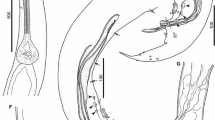Abstract
The pentastomid genus Alofia Giglioli, 1922 (Porocephalida: Sebekidae), which is exclusively parasitic in the bronchioles of crocodiles, is reviewed. The type-species of the taxon, A. ginae Giglioli, 1922 from an unknown host allegedly taken in Samoa, had very distinctive, fine hooks with long slender blades bent at right angles. I describe a single female with identical hooks from the Philippines which was almost certainly derived from the marine crocodile Crocodylus porosus. This same host harboured two specimens of another Alofia species, tentatively identified as A. merki Giglioli, 1922, a species originally described with A. ginae (and, in all probability, from the same (unknown) host). Additional male and female specimens of A. merki, from several specimens of Australian C. porosus, re-affirm the characteristics of this species. Another new Alofia species, A. simpsoni, from an unknown host in Ghana, is established from measurements of two slide-mounted specimens (previously labelled Sebekia) from The Natural History Museum. There can be little doubt that its host is also a crocodile.
A new monotypic genus Selfia is described, based on a type-series of 14 female and one male pentastomids dissected from the bronchioles of five specimens of C. porosus, all taken in Australia. Of the genera comprising the family Sebekidae (Alofia, Sebekia, Diesingia and Leiperia) Selfia is closest to the first, and its main diagnostic characteristics include a massive Alofia-like body, but with a markedly tapered, bluntly-rounded tail, and small, smooth ‘linear’ hooks with minute blades. The rear part of the anterior hooks are enveloped by a soft, cowl-like extension to the fulcrum, covered by small spines. The oral cadre is not U-shaped as in Alofia, but is more like that of Sebekia, whereas by contrast the male copulatory spicules of Selfia porosus and Alofia spp. are virtually identical, except in size.
One previously described Alofia sp. from South American crocodilians is well characterized and valid, but two others are considered species inquirendae.
Similar content being viewed by others
References
Abele, L.G., Kim, W, & Felgenhauer, B.E. (1989) Molecular evidence for the inclusion of the phylum Pentastomida in the Crustacea. Molecular and Biochemical Evolution, 6, 685–691.
Banaja, A.A., James, J.L. & Riley, J. (1977) Observations on the osmoregulatory system of pentastomids: the tegumental chloride cells. International Journal for Parasitology, 7, 27–40.
Fain, A. (1961) Les pentastomides de l'Afrique centrale. Annales de Musee Royale de l'Afrique Centrale, Series 8, 92, 1–115.
Fonseca, F. & Ruiz, J.M. (1956) Was ist eigentilch Pentastoma megastomum Diesing 1836? (Porocephalida, Porocephalidae). Senckenbergiana Biologica 37, 469–485.
Giglioli, G.S. (1922) The new genus Alofia of the family Linguatulidae. An anatomical account of A. ginae. Journal of Tropical Medicine and Hygiene, 30, 371–377.
Hett, M.L. (1924) On the family Linguatulidae. Proceedings of the Zoological Society of London, (1924), 107–159.
Heymons, R. (1935) Pentastomida. In: Bronns Klassen und Ordnungen das Tierreichs. Leipzig: Akademische Verlagsgesellschaft, 5, pp. 1–268.
Heymons, R. (1941a) Beitrage zur Systematik der Pentastomiden VI. Die arten der Gattung Alofia im Vergleich mit Sebekia. I. Ubersicht uber Arten. Zeitschrift für Parasitenkunde, 12, 419–432.
Heymons, R. (1941b) Beitrage zur Systematik der Pentastomiden VI. Die Tippenexemplare von Diesingia megastoma. Zeitschrift für Parasitenkunde, 12, 330–339.
Hirst, S. (1922) On a new linguatulid from the Adriatic. Annals and Magazine of Natural History, Series 9, 10, 289.
Lohrmann, E. (1889) Untersuchungen uber den anatomischen. Bau der Pentastomen. Archiv für Naturgeschichte, 1, 303–337.
Neill, W.T. (1971) The last of the ruling reptiles: alligators, crocodiles and their kin. New York and London: Columbia University Press, pp. 293–322.
Overstreet, R.M., Self, J.M. & Vliet, K.A. (1985) The pentastomid Sebekia mississippiensis n. sp. in the American alligator and other hosts. Proceedings of the Helminthological Society of Washington, 52, 266–277.
Riley, J. (1973) The structure of the buccal cavity in relation to the method of feeding of Reighardia sternae Diesing 1864 (Pentastomida). International Journal for Parasitology, 3, 149–156.
Riley, J., Spratt, D.M. & Winch, J.M. (1990) A revision of the genus Sebekia Sambon, 1922 (Pentastomida) from crocodilians with descriptions of five new species. Systematic Parasitology, 16, 1–25.
Sambon, L.W. (1922) A synopsis of the family Linguatulidae. Journal of Tropical Medicine and Hygiene, 25, 188–206: 391–428.
Self, J.T. & Rego, A.A. (1985) Reassessment and revisions of certain genera and species of the family Sebekidae (Pentastomida) including description of Sebekia microhamus n. sp. Systematic Parasitology, 7, 33–41.
Young, J.Z. (1981) The life of vertebrates. (3rd Ed.) Oxford: Oxford University Press, 645 pp.
Webb, G.J.W., Manolis, S.C. & Buckworth, R.C. (1982) Crocodylus johnstoni in the McKinlay River area. Northern Territory. I. Variation in the diet and a new method of assessing the relative importance of prey. Australian Journal of Zoology, 30, 877–899.
Author information
Authors and Affiliations
Rights and permissions
About this article
Cite this article
Riley, J. A revision of the genus Alofia Giglioli, 1922 and a description of a new monotypic genus, Selfia: two genera of pentastomid parasites (Porocephalida: Sebekidae) inhabiting the bronchioles of the marine crocodile Crocodylus porosus and other crocodilians. Syst Parasitol 29, 23–41 (1994). https://doi.org/10.1007/BF00009836
Accepted:
Issue Date:
DOI: https://doi.org/10.1007/BF00009836




